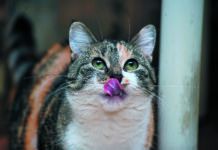Experts recommend that cats be kept indoors for their safety and overall health. However, if the indoor environment isn’t configured to meet their basic feline needs, it may predispose them to feline idiopathic cystitis (FIC). New evidence points to the importance of reducing stress in cats through the following measures:
Food and water: Canned food is recommended for cats with urinary tract problems because of its high water content. Cats prefer to eat individually in quiet locations away from noise or threats. Consider experimenting with fountains, dripping water, and different sizes and shapes of bowls. It’s important to have multiple, separate resource stations in different parts of your home, especially in multi-cat households.
Space: Cats need a safe haven that is quiet, elevated and secure. They love to monitor their world from high above it, so provide plenty of elevated retreats such as cat trees, perches, climbing frames, hammocks, shelves and window seats. These spaces can also double as sleeping areas.
Elimination: Litter boxes should be located in a quiet area away from other animals, loud noises and appliances, and boxes should be large — the bigger, the better. Most cats have litter preferences, and unscented, fine-grained clumping litter is recommended for cats with urinary problems. Litter boxes should be scooped twice daily, cleaned weekly and replaced if they retain odors. The litter box is a resource, and as with food and water, there should be multiple boxes and locations. The traditional rule is 1+1 (one box for each cat, plus one extra).
Social: Our cats benefit from positive, predictable, regular social interaction with us, which helps to strengthen the human-animal bond. Most cats enjoy frequent, low-intensity interactions with both humans and other animals in which they can initiate, moderate and end the social interaction. Conflicts can arise when cats feel threatened — and they may become aggressive, withdrawn or even ill. Conflict is particularly common in multi-cat households when a cat may feel a loss of control, status and resources.
Behavioral: An enriched indoor environment should provide outlets for natural behaviors such as scratching, chewing and playing. Provide vertical and horizontal scratching objects made from a variety of materials such as sisal rope, natural bark or cardboard. Play mimics the predatory hunting sequence of stalk, chase, pounce and bite. Toys that mimic prey — such as wands, feathers, ping pong balls in a bathtub, etc. — can help to satisfy the natural behavior. Experts stress that cats should never be punished for engaging in natural behaviors.



